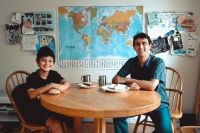In a year unlike any other, the Stanford community was quick to respond to the challenges and uncertainties created by the coronavirus pandemic. Many scholars pivoted their research to tackle the effects of the health crisis, from seeking therapies to treat the disease, to creating tools to speed the development of a vaccine, to better understanding its impact on psychological well-being.
Meanwhile, faculty also transformed their curriculum to meet the new demands of online learning. Students showed resiliency as they adjusted to these new virtual learning spaces and staff too found new ways to connect with one another while working from home. Despite these setbacks, research also continued with innovations in science and technology and new understandings about the world from the social sciences, arts and humanities. And in the wake of George Floyd’s tragic death in Minneapolis, students, staff and faculty came together to find ways to tackle anti-Black racism and advance diversity and inclusion at Stanford and in society.
Stanford also found a few moments to celebrate some notable accomplishments, including the Nobel Memorial Prize in Economic Sciences, two MacArthur “genius” grants and three students named Rhodes Scholars.
Here’s a roundup of those and other reflections from the year.
Go to the web site to view the video.













































